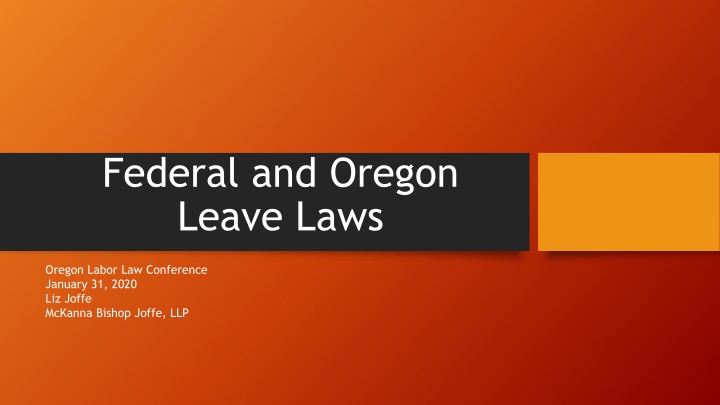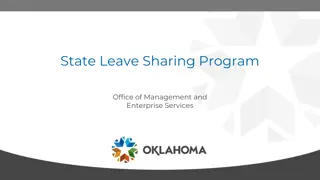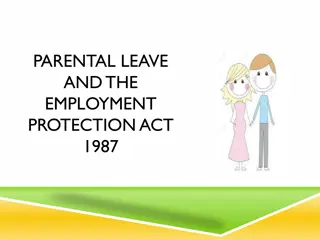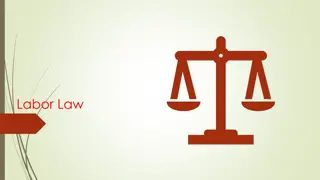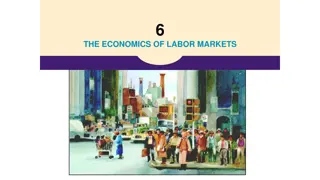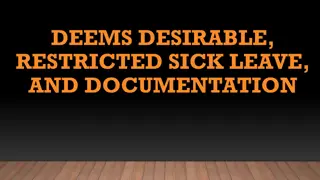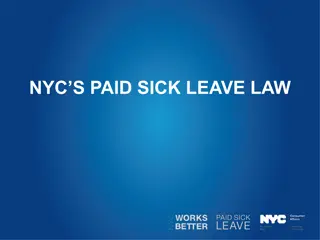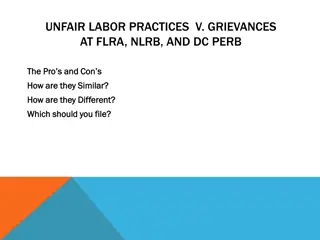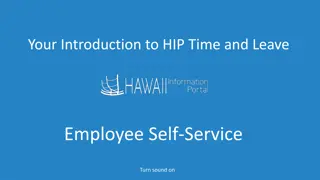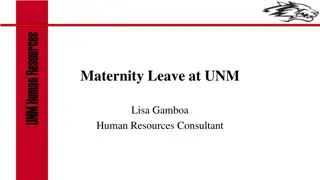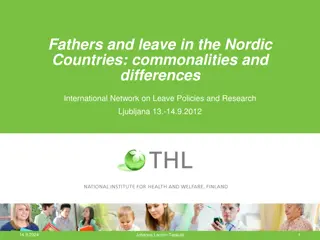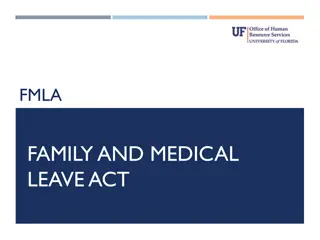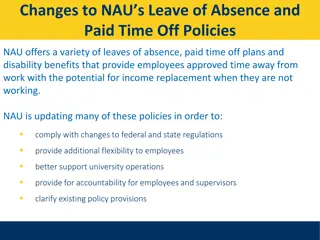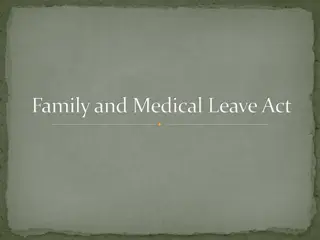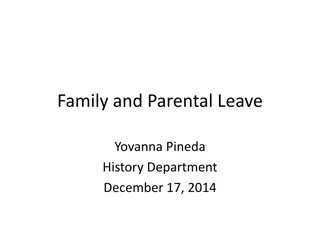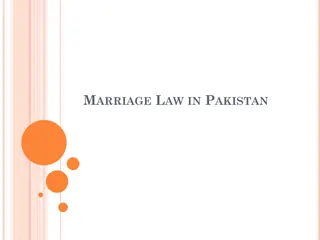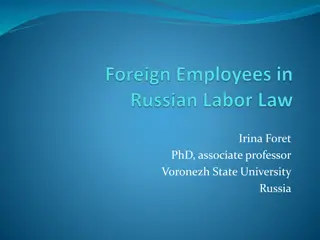Oregon Labor Law Conference - Federal and Oregon Leave Laws
Learn about the Federal Family Medical Leave Act (FMLA), Oregon Family Leave Act (OFLA), Oregon's Paid Sick Leave Law, and upcoming Oregon Paid Family and Medical Leave Law. Understand the key provisions, effective dates, and benefits of these laws to ensure compliance and support for employees. Stay informed about the latest legal updates and requirements.
Uploaded on Mar 01, 2025 | 0 Views
Download Presentation

Please find below an Image/Link to download the presentation.
The content on the website is provided AS IS for your information and personal use only. It may not be sold, licensed, or shared on other websites without obtaining consent from the author.If you encounter any issues during the download, it is possible that the publisher has removed the file from their server.
You are allowed to download the files provided on this website for personal or commercial use, subject to the condition that they are used lawfully. All files are the property of their respective owners.
The content on the website is provided AS IS for your information and personal use only. It may not be sold, licensed, or shared on other websites without obtaining consent from the author.
E N D
Presentation Transcript
Federal and Oregon Leave Laws Oregon Labor Law Conference January 31, 2020 Liz Joffe McKanna Bishop Joffe, LLP
The Six Laws on Your Chart The federal Family Medical Leave Act (FMLA) The Oregon Family Leave Act (OFLA) Oregon s Paid Sick Leave Law The Oregon Military Family Leave Act (OMFLA) Oregon s Law Providing Leave to Crime Victims to Attend Criminal Proceedings Oregon s Law Providing Leave to Victims of Domestic Violence, Sexual Assault, Harassment or Stalking
Coming Soon: Oregons PAID Family and Medical Leave Law The 2019 Oregon Legislature passed and on 8/9/19 Governor Brown signed HB 2005 into law. Up to 12 weeks of paid leave per year. Creates the Family and Medical Leave Insurance (FAMLI) Program, funded by payroll contributions, and administered by the Oregon Employment Department The payroll tax cannot exceed 1% of the employee s wages and will be set by the Employment Department. Employers with 25 or more employees will contribute 40% of the total rate, and the remaining 60% will be deducted from employees wages. Employers may, however, pay the employee s portion, so BARGAIN FOR THIS. Employers with fewer than 25 employees are not required to pay the employer contribution. If they elect to do so, they will be eligible for grants to help cover the cost of replacement workers. Eligible employees still must pay their contribution and will still be eligible for paid family leave benefits.
Oregons FAMLI Program (cont.) Effective Dates: September 1, 2021: Deadline for the Employment Department to issue administrative rules implementing the FAMLI Program. January 1, 2022: Employee payroll contributions begin; Employers must provide written notice to employees of their rights under the FAMLI Program. January 1, 2023: Employees who have earned at least $1,000 in their base year (first four of last five quarters) may begin using paid leave. January 1, 2025: Employees may sue employers for non-compliance.
Oregons FAMLI Program (cont.) The weekly benefit amount is capped at 120% of the state average weekly wage (SAWW)* and has a floor of 5% of the SAWW. Employees who earn less than 65% of the SAWW will receive 100% of their average weekly wage. Employees who earn more than 65% of the SAWW will receive 65% of the state average weekly wage plus 50% of the amount by which the employee s average weekly wage exceeds the SAWW. Employees may also use vacation or sick time to supplement their weekly benefit amount, up to 100% of their wages. * The SAWW for 7/1/19 through 6/30/20 is $1,044.40.
Oregons FAMLI Program (cont.) Reasons for Taking FAMLI Leave Family leave: To care for and bond with a child during the first year after the child s birth or placement through foster care or adoption (FMLA/OFLA); or To care for a family member with a serious health condition (FMLA/OFLA); Medical Leave: Leave necessary due to the employee s own serious health condition (FMLA/OFLA). Safe Leave: Leave for any purpose covered under the law providing protections to victims of domestic violence, harassment, sexual assault, or stalking It is not available for sick child leave (OFLA), death of a family member (OFLA), or for military exigencies (OMFLA) FAMLI leave must be taken concurrently with FMLA and OFLA leave, but is in addition to paid sick leave, PTO, or paid vacation. It can be taken in increments of one work day or one work week (to be defined by Employment Department rule). Employees cannot take FAMLI leave during weeks they are eligible to receive workers compensation or unemployment benefits.
Oregons FAMLI Program (cont.) THINK ABOUT BARGAINING NOW!! The law expressly states that nothing in it requires the reopening or renegotiation of CBAs entered into before the effective date of the law, and that the requirements are minimums that do not preempt, limit or otherwise diminish CBA provisions that provide for greater use of family, medical or safe leave. Employers who provide equivalent paid leave under their own plan can request an exemption through a formal application process. Must cover all employees who have been continuously employed for 30 days The benefits must be equal to or greater than the weekly FAMLI benefits Need not be fully paid for by the employer, provided that any employee-paid portion cannot exceed what they would pay under the law. Theoretically could bargain funding that would be better than the 60-40 split under the law. Equivalent plan must be in addition to paid sick leave under ORS 653.606. Can also bargain for employers to pick-up the employees 60% of the payroll tax.
Employee Eligibility Under FMLA & OFLA Employees must meet both of these prongs: 1) Length of employment - FMLA: 12 months - OFLA: 180 days 2) Hours worked - FMLA: 1,250 hours in the preceding 12 months - OFLA: average of 25 hours/week in preceding 180 days (except there is no hours worked requirement for parental leave under OFLA)
Leave Year There are four ways to determine the leave year: 1. Calendar Year 2. Another Fixed Year (e.g. fiscal year) 3. Measuring Forward (12 months forward from date first leave begins; does not re-set until first time use leave again after the 12-month period) 4. Rolling Backward (12 months backward from date seek to use leave)
Additional Reasons for OFLA Leave (beyond FMLA reasons) 1) Sick child leave Child is too sick to go to school or daycare 2) Bereavement leave Up to two weeks per death of family member (12 weeks max) To attend funeral, make arrangements (funeral planning, financial matters, moving out of house, legal), grieving
What is a Family Member? FMLA: spouse, minor or adult disabled child, or parent (or one standing in the place of a parent or child) OFLA: same as FMLA plus grandparents and grandchildren, parents-in-law, registered same-gender domestic partners and children and parents of registered same-gender domestic partners, and all adult children.
Two Parents working for Same Employer Under FMLA, married parents get only a combined total of 12 weeks of parental leave, but they can take it at the same time Under OFLA, they each get 12 weeks, but employers are not required to allow them to take it at the same time (unless one of them or the child is suffering from a serious health condition) If employees are covered/eligible under both laws, then they get the best of both worlds: They can take a combined total of 12 weeks concurrently after which they could take the balance of the 12 weeks each has remaining separately. [Note, however, that employers can require parental leave to be taken in one chunk.]
Medical Certification Must be provided before leave if leave is foreseeable If unforeseeable, have 15 days from employer s request to submit Employers can ask employees to cure deficiencies (e.g. answers left blank). FMLA: 7 days to cure; OFLA: reasonable time to cure FMLA: certain managers (not the employee s supervisor) can contact health care provider for purposes of authentication (did you complete/sign this) or clarification (I can t read what you wrote for #7); OFLA: only the employer s health care provider can contact employee s health care provider and only for these reasons. Employer can obtain 2ndopinion if it has reason to doubt the certification. Can t be the company doctor. If the two opinions differ, then the employer and employee can mutually select a third provider.
Recertification If the minimum duration of a condition is more than 30 days, then the employer must wait until that duration expires to request recertification. But, the employer can seek recertification of the same condition at least every six months, even if the duration of the condition is longer than six months. The only reasons justifying recertification in less than 30 days are: - the employee requests an extension of the leave; - circumstances described by the previous certification have changed significantly (e.g. use of substantially more intermittent leave) - the employer receives information that casts doubt on the validity of the certification There are no 2ndand 3rdopinions on recertifications
The Escriba confusion Escriba Held an employee can affirmatively decline to use FMLA even if the reason for the leave would be FMLA-protected. Contrary to longstanding expectation of employers. US Department of Labor FMLA Opinion Letter (FMLA2019-1-A), March 14, 2019: Employer is responsible for designating leave as FMLA-qualifying after it has enough information to determine whether the leave is being taken for an FMLA-qualifying reason. Fn 3: WHD therefore disagrees with the Ninth Circuit s holding than an employee may use non-FMLA leave for an FMLA-qualifying reason and decline to use FMLA leave in order to preserve FMLA leave for future use.
